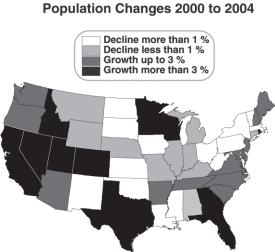According to the U.S. Census Bureau the population of the U.S. will surpass the 300 million mark today (at 7:45 am eastern standard time, right about…..NOW). It is the only industrialized nation in the world whose population is rising substantially. (via)
3: The United States is the world’s third largest population after China and India, both of whose populations are also rising.
7: The number of people who are born every second in the U.S.
31: The number of migrants who enter the U.S. every second.
34 million: The number of foreign-born people living in the U.S. in 2004 compared with just 9.7 million in 1967.
2043: The year the Census Bureau predicts the U.S. population will reach 400 million.
1.5 million: The number of people living now living in Phoenix, Arizona, compared with under half a million 40 years ago. The country has witnessed huge demographic changes, with a shift in population from the Northwest and Midwest to the West and South.
50 percent: Half of the U.S. population lives in suburbs compared with 38 per cent in the 1970s.
50 percent: The number of married couple households has fallen to 50 percent from 75 percent in 1967.
26 percent: The percentage of people who live alone as young people marry later and older people who are divorced or widowed don’t remarry.
2.3kg: The amount of trash each American produces every day — about five times more than a person in a developing country.
25 percent: The amount of the world’s energy consumed by the U.S. The country is also the single largest emitter of carbon dioxide.
1,000: The number of plants and animals listed as endangered species because of loss of habitat due to land development.
3: The number of times more water each American uses than the world average. The U.S. has also lost half of its wetlands to urban development and agriculture.

From here
THE population of the US is scheduled to officially hit 300 million at 7.46am (EDT) today, when the Census Bureau’s population clock rolls over to the big number.
…
It is not easy estimating the exact number of people in a country the size of the US. It gets even more complicated when you take into account illegal immigration, another reason for the federal government to let the milestone pass quietly.
When the US population officially hit 200 million in 1967, President Lyndon B. Johnson held a news conference at the Commerce Department to hail America’s past and to talk about the challenges ahead. Life magazine dispatched a cadre of photographers to find a baby born at the exact moment, anointing a boy born in Atlanta as the 200 millionth American.
This year, there is a good chance the 300 millionth American has already walked across the border from Mexico.
“It’s a couple of weeks before an election when illegal immigration is a high-profile issue and they don’t want to make a big deal out of it,†said William Frey, a demographer at the Brookings Institution, a Washington think tank.
Commerce Secretary Carlos Gutierrez said the Bush administration was not playing down the milestone, though he said he had no plans for today. Census Bureau employees planned to mark the moment this afternoon with cake and punch.
“I would hate to think that we are going to be low key about this,†said Gutierrez, whose department oversees the Census Bureau. “I would hope that we make a big deal about it.â€
…
The US adds about 2.8 million people a year, for a growth rate of less than 1%. About 40% of the growth comes from immigration. The rest comes from births outnumbering deaths.
The Census Bureau counts the population every 10 years. In between, it uses administrative records and surveys to estimate monthly averages for births, deaths and net immigration. The bureau has a “population clock†that estimates a birth every seven seconds, a death every 13 seconds and a new immigrant every 31 seconds. Add it together and you get one new American every 11 seconds.
A growing US population is something to be seriously worried about. I’m personally not too concerned at the moment how the Chinese or Indian population grows providing overall global consumption can be curtailed. But this is not the case, and consumption is growing in many developing countries, so we can ill-afford to have continued population growth in the USA, and UK for that matter (just passed 60 million), while the per capita consumption is so high.
Have a look at http://earth-blog.bravejournal.com/entry/17204 for a detailed analysis.